BIT121: Network Design and Communication Modes Report for AgroXYZ
VerifiedAdded on 2023/03/17

Network Design and Communication Modes
Name of the Student
Name of the University
Author Note
Paraphrase This Document
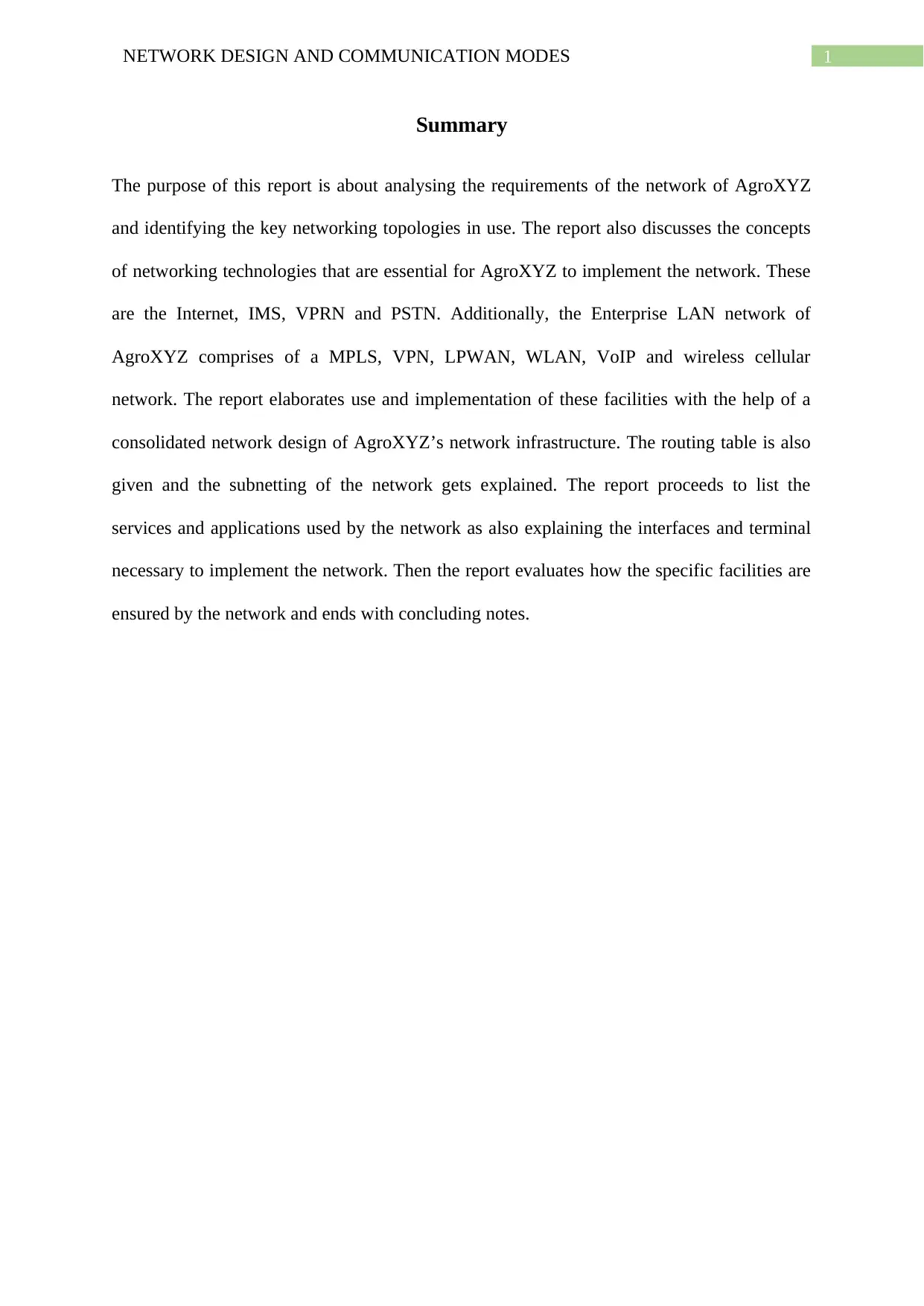
Summary
The purpose of this report is about analysing the requirements of the network of AgroXYZ
and identifying the key networking topologies in use. The report also discusses the concepts
of networking technologies that are essential for AgroXYZ to implement the network. These
are the Internet, IMS, VPRN and PSTN. Additionally, the Enterprise LAN network of
AgroXYZ comprises of a MPLS, VPN, LPWAN, WLAN, VoIP and wireless cellular
network. The report elaborates use and implementation of these facilities with the help of a
consolidated network design of AgroXYZ’s network infrastructure. The routing table is also
given and the subnetting of the network gets explained. The report proceeds to list the
services and applications used by the network as also explaining the interfaces and terminal
necessary to implement the network. Then the report evaluates how the specific facilities are
ensured by the network and ends with concluding notes.

Table of Contents
Introduction................................................................................................................................3
Solution Design..........................................................................................................................3
Requirements Summary.........................................................................................................3
Network Topologies...............................................................................................................4
Local Area Network (LAN)...............................................................................................4
Wide Area Network (WAN)..............................................................................................4
Wireless LAN (WLAN).....................................................................................................4
Internet Concept.....................................................................................................................5
IP Multimedia Subsystem Concept IMS................................................................................6
Virtual Private Routed Network VPRN.................................................................................7
Public Switched Telephone Network PSTN..........................................................................8
Consolidated Network Design...............................................................................................9
Subnet Calculation...............................................................................................................11
Services and Applications....................................................................................................11
Interfaces and Terminals......................................................................................................12
Analysis and Evaluation...........................................................................................................12
Conclusion................................................................................................................................13
References................................................................................................................................14
⊘ This is a preview!⊘
Do you want full access?
Subscribe today to unlock all pages.

Trusted by 1+ million students worldwide
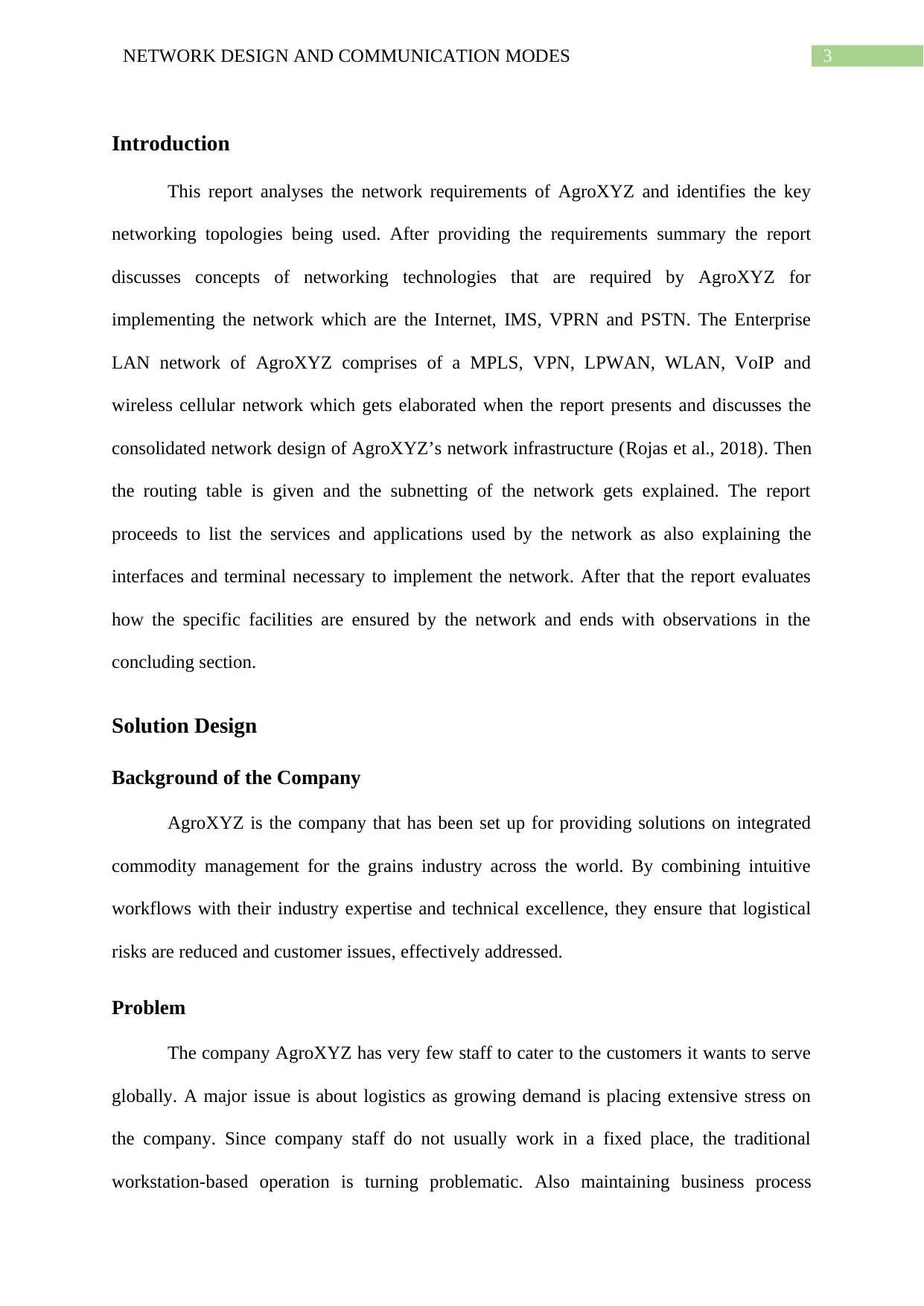
Introduction
This report analyses the network requirements of AgroXYZ and identifies the key
networking topologies being used. After providing the requirements summary the report
discusses concepts of networking technologies that are required by AgroXYZ for
implementing the network which are the Internet, IMS, VPRN and PSTN. The Enterprise
LAN network of AgroXYZ comprises of a MPLS, VPN, LPWAN, WLAN, VoIP and
wireless cellular network which gets elaborated when the report presents and discusses the
consolidated network design of AgroXYZ’s network infrastructure (Rojas et al., 2018). Then
the routing table is given and the subnetting of the network gets explained. The report
proceeds to list the services and applications used by the network as also explaining the
interfaces and terminal necessary to implement the network. After that the report evaluates
how the specific facilities are ensured by the network and ends with observations in the
concluding section.
Solution Design
Background of the Company
AgroXYZ is the company that has been set up for providing solutions on integrated
commodity management for the grains industry across the world. By combining intuitive
workflows with their industry expertise and technical excellence, they ensure that logistical
risks are reduced and customer issues, effectively addressed.
Problem
The company AgroXYZ has very few staff to cater to the customers it wants to serve
globally. A major issue is about logistics as growing demand is placing extensive stress on
the company. Since company staff do not usually work in a fixed place, the traditional
workstation-based operation is turning problematic. Also maintaining business process
Paraphrase This Document
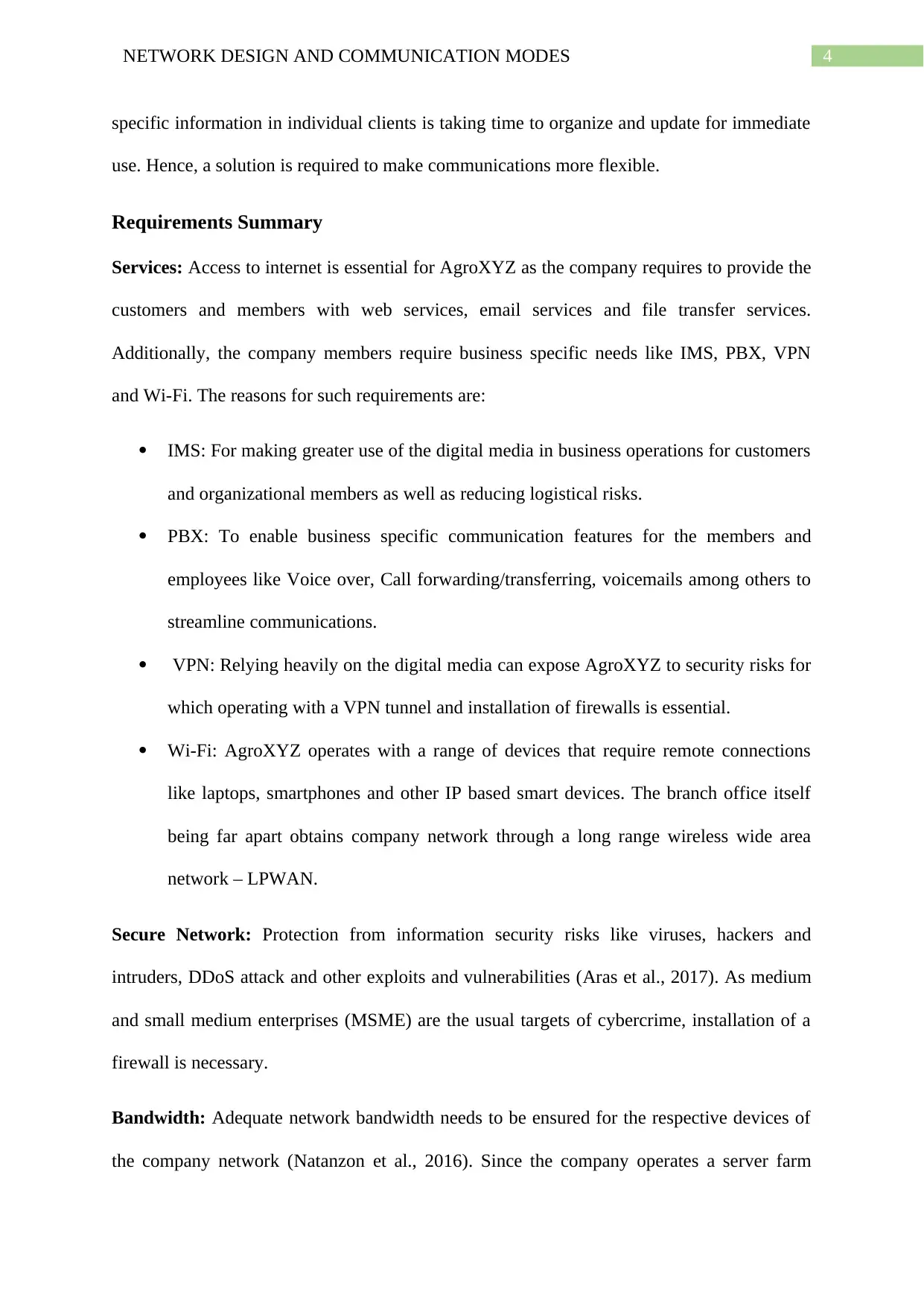
specific information in individual clients is taking time to organize and update for immediate
use. Hence, a solution is required to make communications more flexible.
Requirements Summary
Services: Access to internet is essential for AgroXYZ as the company requires to provide the
customers and members with web services, email services and file transfer services.
Additionally, the company members require business specific needs like IMS, PBX, VPN
and Wi-Fi. The reasons for such requirements are:
IMS: For making greater use of the digital media in business operations for customers
and organizational members as well as reducing logistical risks.
PBX: To enable business specific communication features for the members and
employees like Voice over, Call forwarding/transferring, voicemails among others to
streamline communications.
VPN: Relying heavily on the digital media can expose AgroXYZ to security risks for
which operating with a VPN tunnel and installation of firewalls is essential.
Wi-Fi: AgroXYZ operates with a range of devices that require remote connections
like laptops, smartphones and other IP based smart devices. The branch office itself
being far apart obtains company network through a long range wireless wide area
network – LPWAN.
Secure Network: Protection from information security risks like viruses, hackers and
intruders, DDoS attack and other exploits and vulnerabilities (Aras et al., 2017). As medium
and small medium enterprises (MSME) are the usual targets of cybercrime, installation of a
firewall is necessary.
Bandwidth: Adequate network bandwidth needs to be ensured for the respective devices of
the company network (Natanzon et al., 2016). Since the company operates a server farm

along with a number of other devices of the workplace, 1 Gbps of overall network bandwidth
is required.
Wireless Connectivity: To ensure convenient network access to devices like laptops and
smartphones wireless connectivity must be set up and wireless access points and WLAN
connectors can enable this facility. The branches being located far from one another nee long
range wireless communications.
Network Topologies
Local Area Network (LAN)
The most common networking topology is the LAN topology which stands for Local
Area Networking (Rahim et al., 2018). Most of the networks in the world can be seen using
this topology for building their respective network. In LAN networks devices be connected in
several ways, be it linearly from one node to the other or through use of hubs and switches in
physical star topology.
Wide Area Network (WAN)
Wide Area Network or WAN can extend over large geographical expanses (Leon,
Parra and Bermudez, 2018). These type of networks in usually noticed among businesses,
educational institutions, personal area networks or PANs, campus area networks or CANs or
even metropolitan area networks or MANs in rooms, buildings, campuses and distinct
metropolitan areas.
Wireless LAN (WLAN)
Another networking topology that is getting more and more popular by the day is
WLAN or Wireless Local Area Networks (Li and Lei, 2016). Here the devices requiring
network access can avail it remotely while in motion. Thus, this networking topology
⊘ This is a preview!⊘
Do you want full access?
Subscribe today to unlock all pages.

Trusted by 1+ million students worldwide

completely alleviates requirements of cables. Although it must be noted that the bandwidth
and response times available from ethernet cables are unmatched.
Internet Concept
Figure 1: Internet Topology
Internet is actually the physical inter connect of all the existing networks of the World
Wide Web (Jiao and Shi, 2016). To accomplish this, the IP protocol of TCP/IP architecture
gets used (Shang et al., 2016). Every client device like PCs, laptops and phones have unique
IP addresses assigned. Such IPs are always distinct number sets which are used to identify the
device location. One example of these IP addresses can be 192.168.1.1.
In the diagram the internet is represented by four transit domains and multiple stub
domains. In communications between the client and the server only a handful of stub
domains get involved. The transit domains are responsible for enable transit related services
for the rest of the domains (Lara et al., 2016). Stub domains connected to one transit domain
are single homed stubs while stub domains connected to multiple transit domains are multi
homed stubs.
Paraphrase This Document
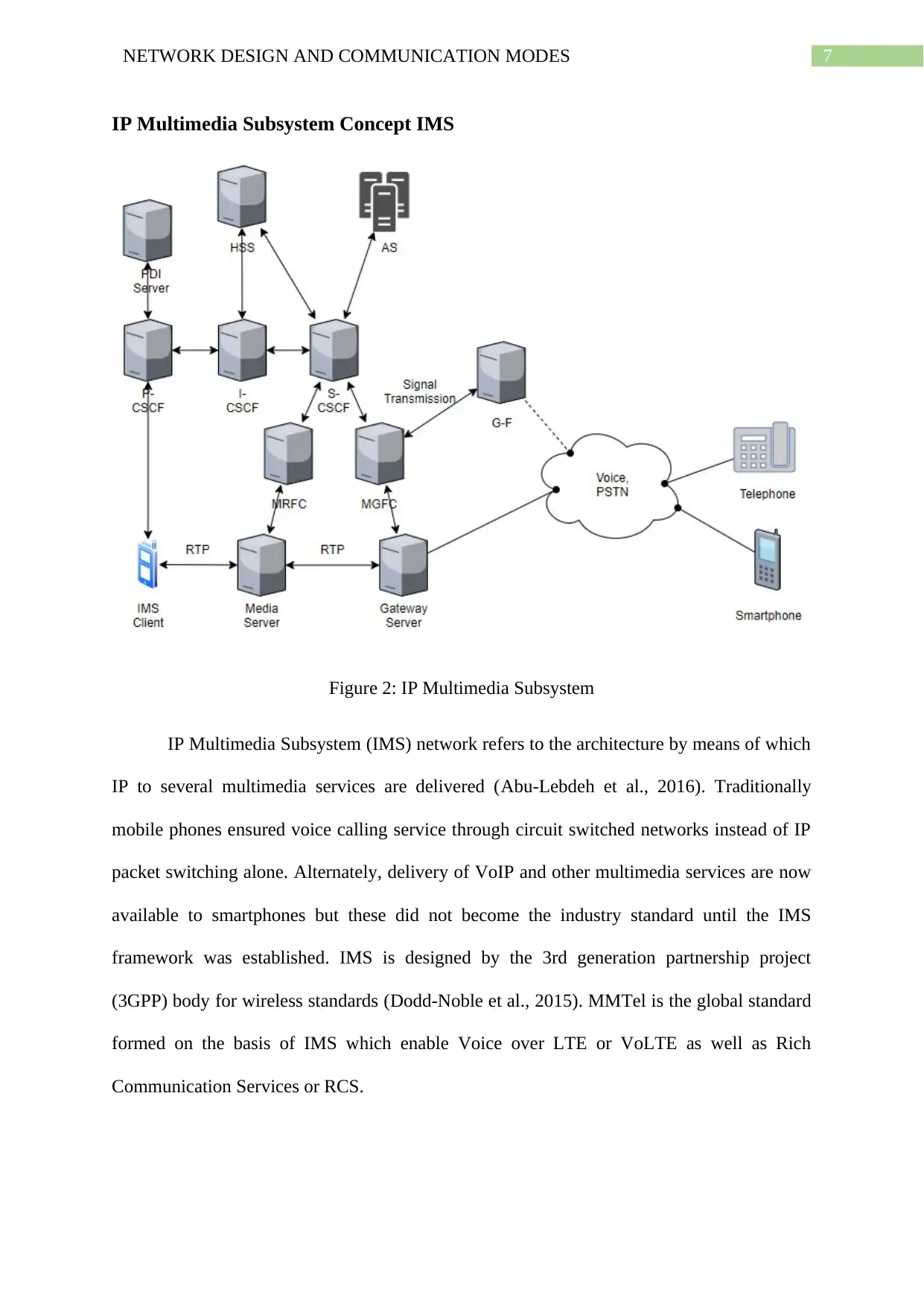
IP Multimedia Subsystem Concept IMS
Figure 2: IP Multimedia Subsystem
IP Multimedia Subsystem (IMS) network refers to the architecture by means of which
IP to several multimedia services are delivered (Abu-Lebdeh et al., 2016). Traditionally
mobile phones ensured voice calling service through circuit switched networks instead of IP
packet switching alone. Alternately, delivery of VoIP and other multimedia services are now
available to smartphones but these did not become the industry standard until the IMS
framework was established. IMS is designed by the 3rd generation partnership project
(3GPP) body for wireless standards (Dodd-Noble et al., 2015). MMTel is the global standard
formed on the basis of IMS which enable Voice over LTE or VoLTE as well as Rich
Communication Services or RCS.

In the diagram the HSS or Home Subscriber Server also called the user profile server
function acts as master database of the users and supports IMS networking entities which
handles the calls. Multiple roles and proxies are served by SIP servers. These are known as
Call Session Control Function or CSCF, used for processing SIP signal packets in IMS
(Nozoe et al., 2016). The three CSCF functions are – Proxy (P-CSCF), Interrogating (I-
CSCF), Serving (S-CSCF). SIP Application Servers or AS are for hosting and executing
services as also interface with S-CSCF through SIP.
Virtual Private Routed Network VPRN
Figure 3: VPRN representation
MPLS or multiprotocol label switching VPN is one of the methods for creating VPNs
or Virtual Private Networks (Ahmed, Butt and Siddiqui, 2016). The three different types of
VPNs under the MPLS family are – Point to point, VPLS (Virtual Private LAN services) and
VPRN (virtual private routed network). This method uses VRF or VPN/virtual routing and
forwarding for segmenting routing tables for all customers who use the service (Liu et al.,
2017). These Layer 3 VPNs are not usually deployed.
⊘ This is a preview!⊘
Do you want full access?
Subscribe today to unlock all pages.

Trusted by 1+ million students worldwide
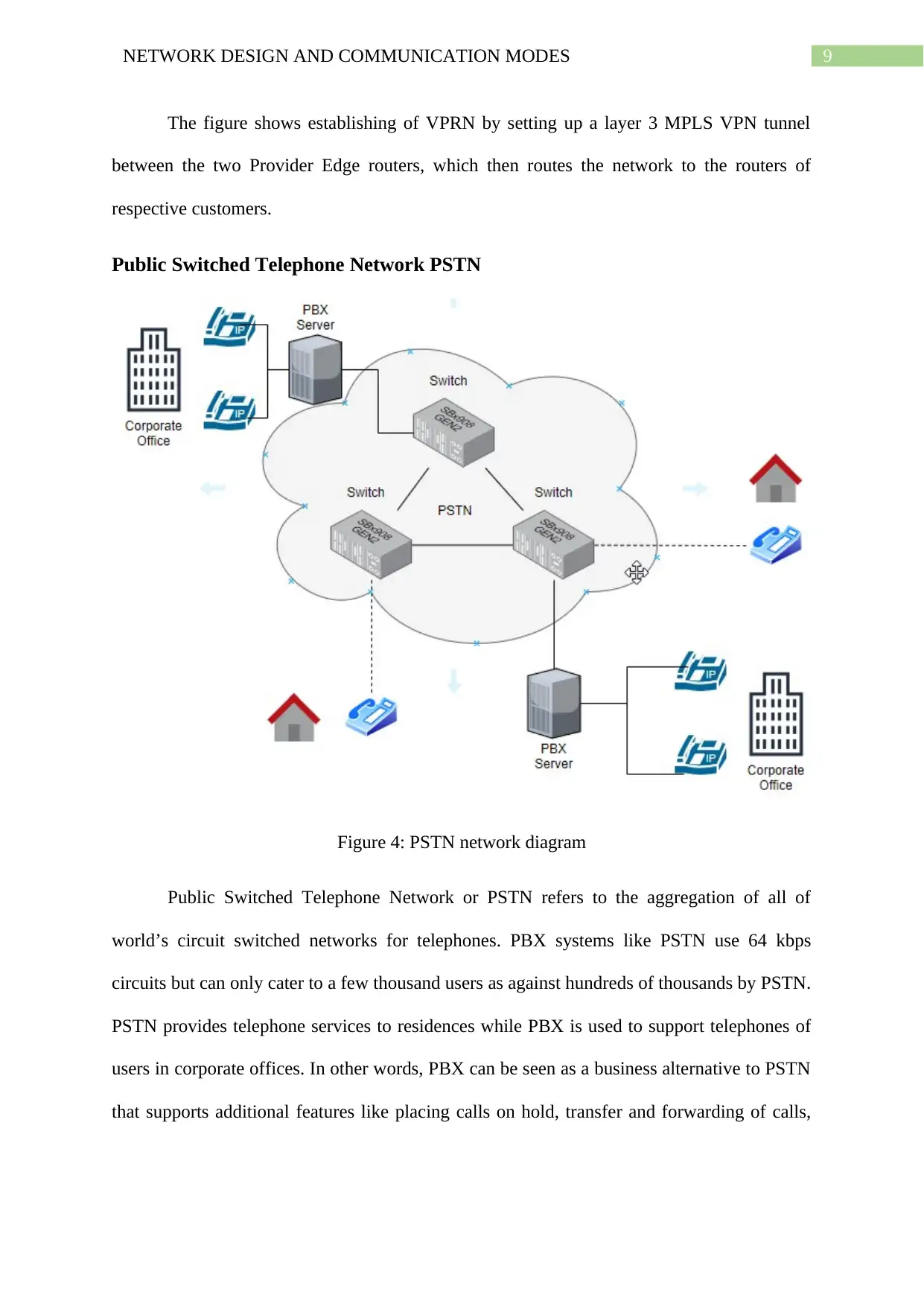
The figure shows establishing of VPRN by setting up a layer 3 MPLS VPN tunnel
between the two Provider Edge routers, which then routes the network to the routers of
respective customers.
Public Switched Telephone Network PSTN
Figure 4: PSTN network diagram
Public Switched Telephone Network or PSTN refers to the aggregation of all of
world’s circuit switched networks for telephones. PBX systems like PSTN use 64 kbps
circuits but can only cater to a few thousand users as against hundreds of thousands by PSTN.
PSTN provides telephone services to residences while PBX is used to support telephones of
users in corporate offices. In other words, PBX can be seen as a business alternative to PSTN
that supports additional features like placing calls on hold, transfer and forwarding of calls,
Paraphrase This Document
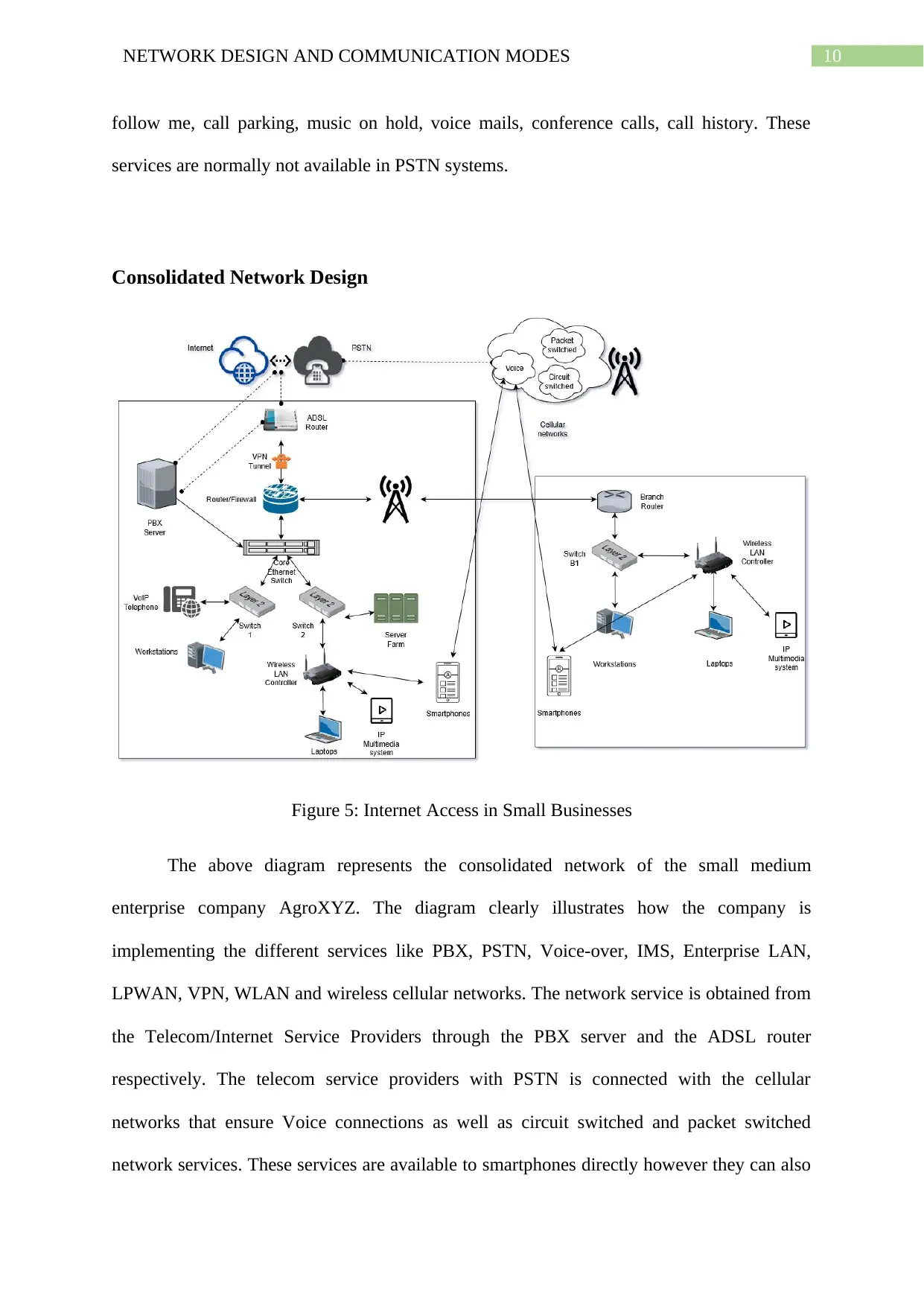
follow me, call parking, music on hold, voice mails, conference calls, call history. These
services are normally not available in PSTN systems.
Consolidated Network Design
Figure 5: Internet Access in Small Businesses
The above diagram represents the consolidated network of the small medium
enterprise company AgroXYZ. The diagram clearly illustrates how the company is
implementing the different services like PBX, PSTN, Voice-over, IMS, Enterprise LAN,
LPWAN, VPN, WLAN and wireless cellular networks. The network service is obtained from
the Telecom/Internet Service Providers through the PBX server and the ADSL router
respectively. The telecom service providers with PSTN is connected with the cellular
networks that ensure Voice connections as well as circuit switched and packet switched
network services. These services are available to smartphones directly however they can also
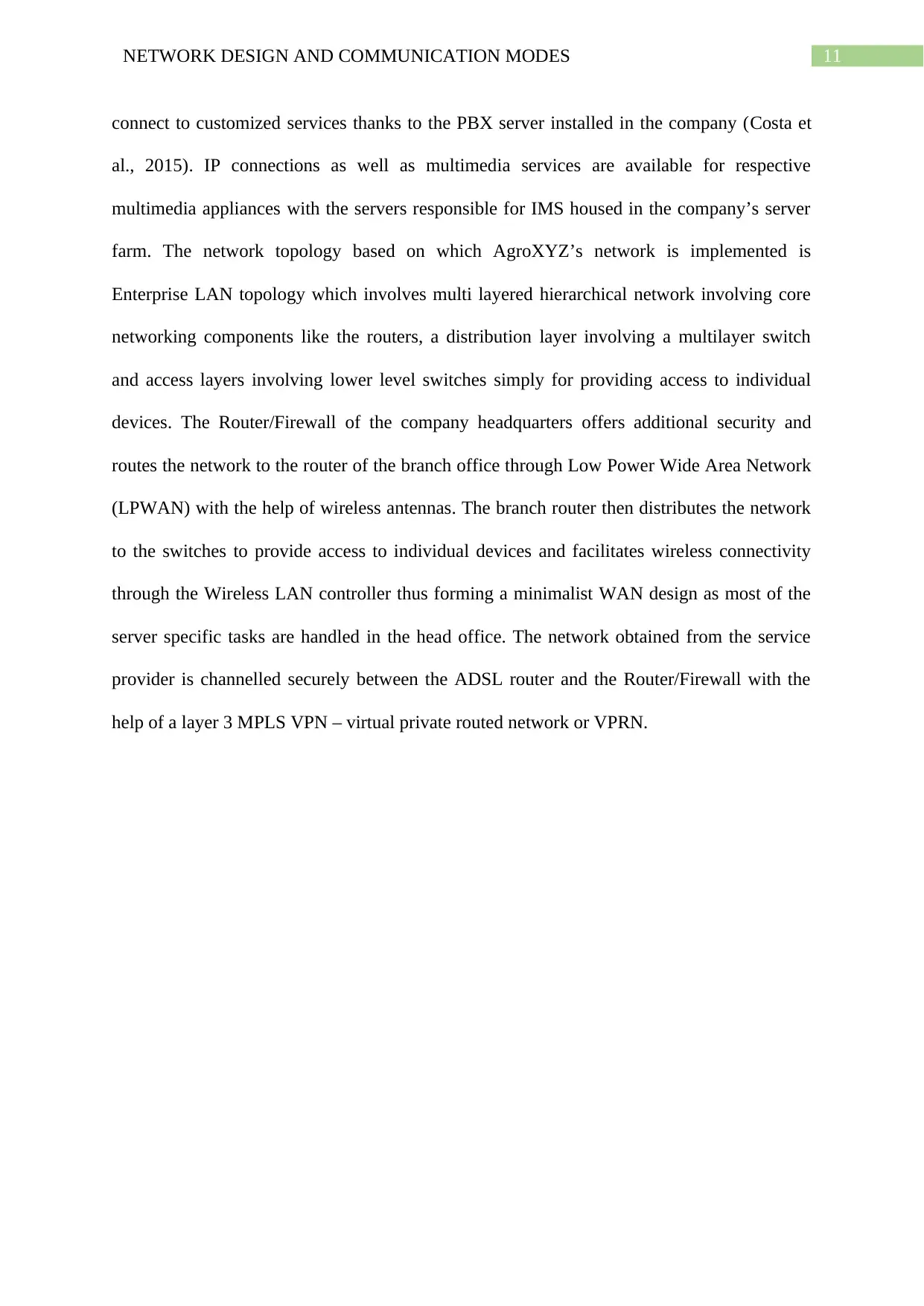
connect to customized services thanks to the PBX server installed in the company (Costa et
al., 2015). IP connections as well as multimedia services are available for respective
multimedia appliances with the servers responsible for IMS housed in the company’s server
farm. The network topology based on which AgroXYZ’s network is implemented is
Enterprise LAN topology which involves multi layered hierarchical network involving core
networking components like the routers, a distribution layer involving a multilayer switch
and access layers involving lower level switches simply for providing access to individual
devices. The Router/Firewall of the company headquarters offers additional security and
routes the network to the router of the branch office through Low Power Wide Area Network
(LPWAN) with the help of wireless antennas. The branch router then distributes the network
to the switches to provide access to individual devices and facilitates wireless connectivity
through the Wireless LAN controller thus forming a minimalist WAN design as most of the
server specific tasks are handled in the head office. The network obtained from the service
provider is channelled securely between the ADSL router and the Router/Firewall with the
help of a layer 3 MPLS VPN – virtual private routed network or VPRN.
⊘ This is a preview!⊘
Do you want full access?
Subscribe today to unlock all pages.

Trusted by 1+ million students worldwide
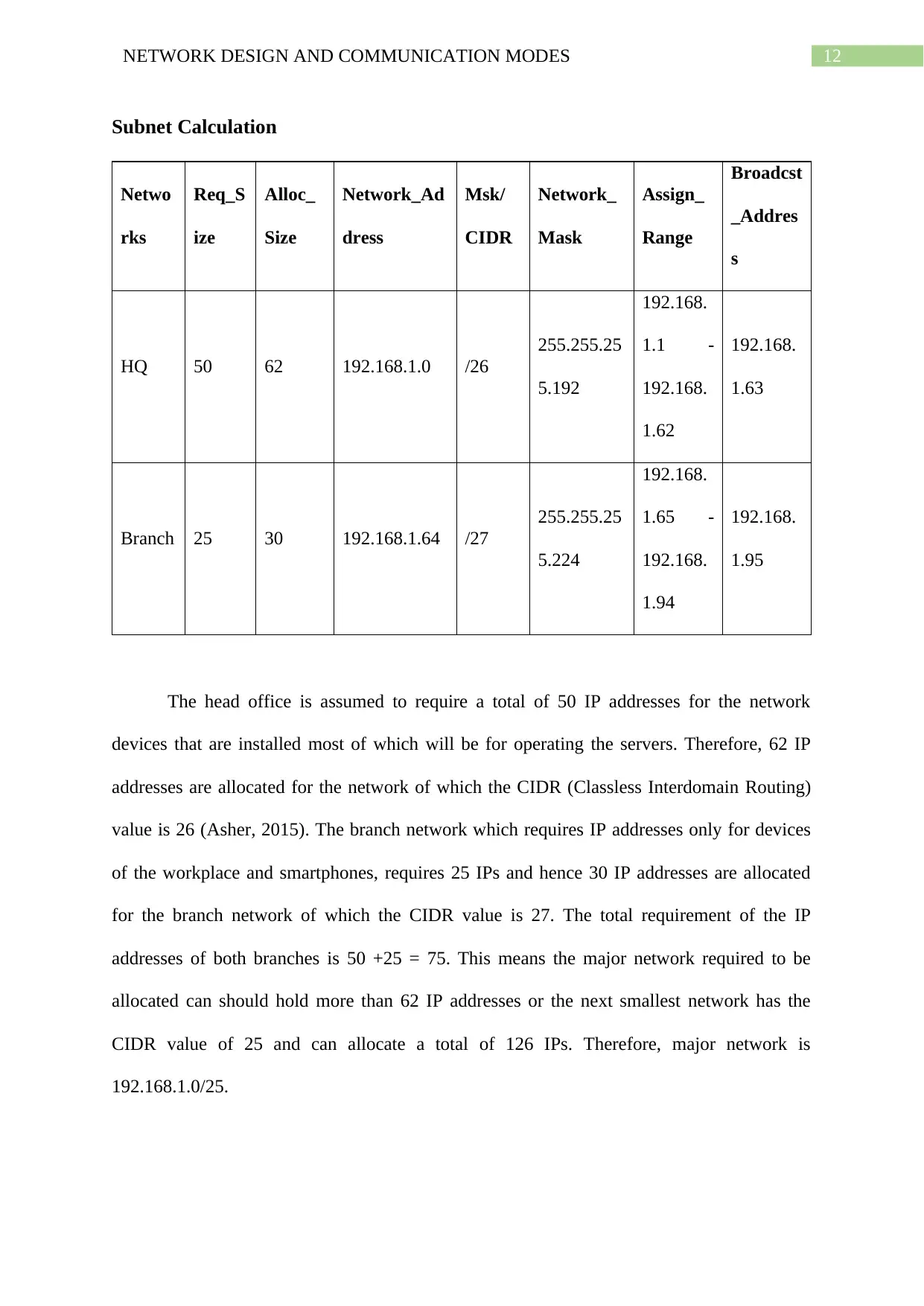
Subnet Calculation
Netwo
rks
Req_S
ize
Alloc_
Size
Network_Ad
dress
Msk/
CIDR
Network_
Mask
Assign_
Range
Broadcst
_Addres
s
HQ 50 62 192.168.1.0 /26
255.255.25
5.192
192.168.
1.1 -
192.168.
1.62
192.168.
1.63
Branch 25 30 192.168.1.64 /27
255.255.25
5.224
192.168.
1.65 -
192.168.
1.94
192.168.
1.95
The head office is assumed to require a total of 50 IP addresses for the network
devices that are installed most of which will be for operating the servers. Therefore, 62 IP
addresses are allocated for the network of which the CIDR (Classless Interdomain Routing)
value is 26 (Asher, 2015). The branch network which requires IP addresses only for devices
of the workplace and smartphones, requires 25 IPs and hence 30 IP addresses are allocated
for the branch network of which the CIDR value is 27. The total requirement of the IP
addresses of both branches is 50 +25 = 75. This means the major network required to be
allocated can should hold more than 62 IP addresses or the next smallest network has the
CIDR value of 25 and can allocate a total of 126 IPs. Therefore, major network is
192.168.1.0/25.
Paraphrase This Document
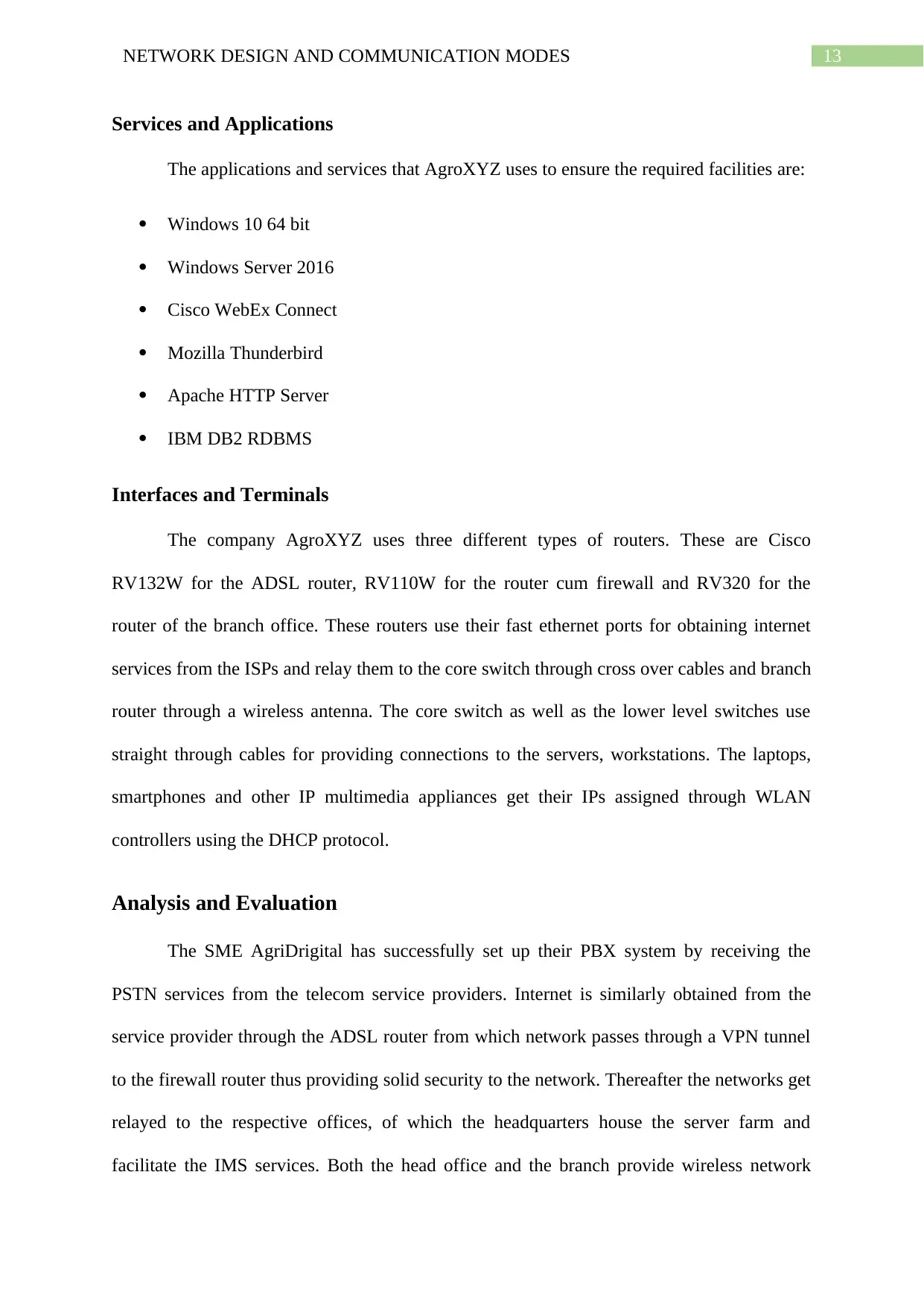
Services and Applications
The applications and services that AgroXYZ uses to ensure the required facilities are:
Windows 10 64 bit
Windows Server 2016
Cisco WebEx Connect
Mozilla Thunderbird
Apache HTTP Server
IBM DB2 RDBMS
Interfaces and Terminals
The company AgroXYZ uses three different types of routers. These are Cisco
RV132W for the ADSL router, RV110W for the router cum firewall and RV320 for the
router of the branch office. These routers use their fast ethernet ports for obtaining internet
services from the ISPs and relay them to the core switch through cross over cables and branch
router through a wireless antenna. The core switch as well as the lower level switches use
straight through cables for providing connections to the servers, workstations. The laptops,
smartphones and other IP multimedia appliances get their IPs assigned through WLAN
controllers using the DHCP protocol.
Analysis and Evaluation
The SME AgriDrigital has successfully set up their PBX system by receiving the
PSTN services from the telecom service providers. Internet is similarly obtained from the
service provider through the ADSL router from which network passes through a VPN tunnel
to the firewall router thus providing solid security to the network. Thereafter the networks get
relayed to the respective offices, of which the headquarters house the server farm and
facilitate the IMS services. Both the head office and the branch provide wireless network
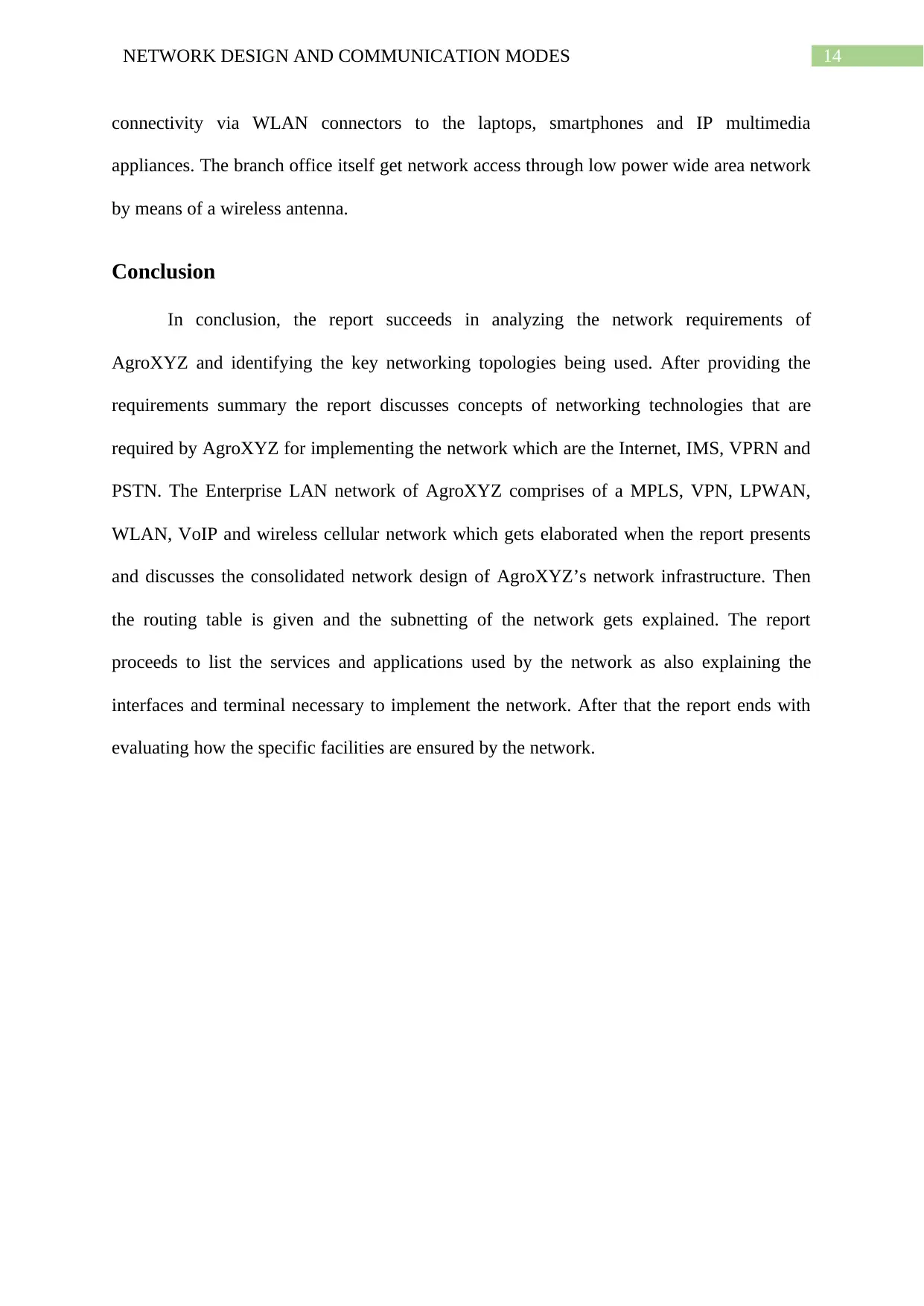
connectivity via WLAN connectors to the laptops, smartphones and IP multimedia
appliances. The branch office itself get network access through low power wide area network
by means of a wireless antenna.
Conclusion
In conclusion, the report succeeds in analyzing the network requirements of
AgroXYZ and identifying the key networking topologies being used. After providing the
requirements summary the report discusses concepts of networking technologies that are
required by AgroXYZ for implementing the network which are the Internet, IMS, VPRN and
PSTN. The Enterprise LAN network of AgroXYZ comprises of a MPLS, VPN, LPWAN,
WLAN, VoIP and wireless cellular network which gets elaborated when the report presents
and discusses the consolidated network design of AgroXYZ’s network infrastructure. Then
the routing table is given and the subnetting of the network gets explained. The report
proceeds to list the services and applications used by the network as also explaining the
interfaces and terminal necessary to implement the network. After that the report ends with
evaluating how the specific facilities are ensured by the network.
⊘ This is a preview!⊘
Do you want full access?
Subscribe today to unlock all pages.

Trusted by 1+ million students worldwide
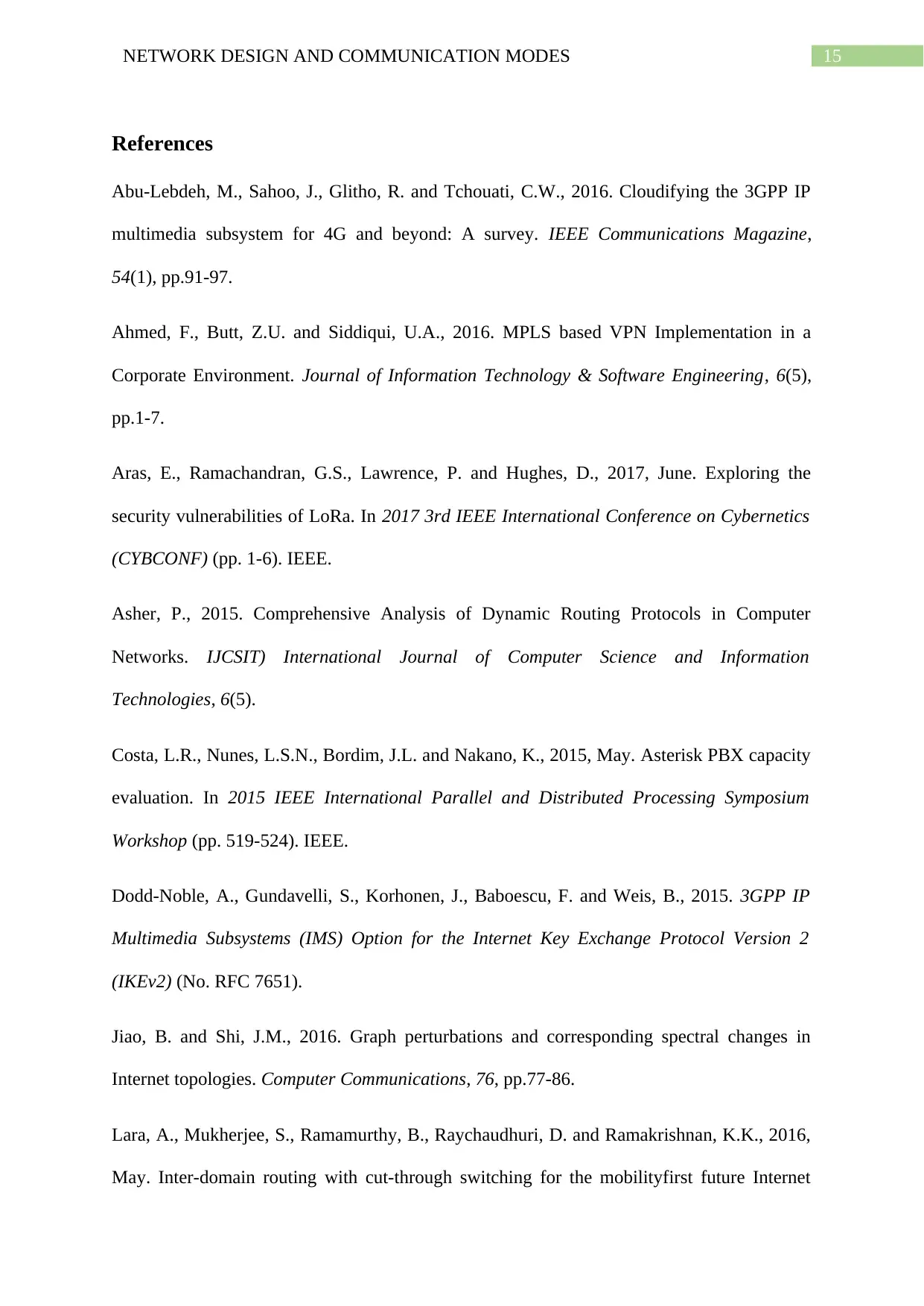
References
Abu-Lebdeh, M., Sahoo, J., Glitho, R. and Tchouati, C.W., 2016. Cloudifying the 3GPP IP
multimedia subsystem for 4G and beyond: A survey. IEEE Communications Magazine,
54(1), pp.91-97.
Ahmed, F., Butt, Z.U. and Siddiqui, U.A., 2016. MPLS based VPN Implementation in a
Corporate Environment. Journal of Information Technology & Software Engineering, 6(5),
pp.1-7.
Aras, E., Ramachandran, G.S., Lawrence, P. and Hughes, D., 2017, June. Exploring the
security vulnerabilities of LoRa. In 2017 3rd IEEE International Conference on Cybernetics
(CYBCONF) (pp. 1-6). IEEE.
Asher, P., 2015. Comprehensive Analysis of Dynamic Routing Protocols in Computer
Networks. IJCSIT) International Journal of Computer Science and Information
Technologies, 6(5).
Costa, L.R., Nunes, L.S.N., Bordim, J.L. and Nakano, K., 2015, May. Asterisk PBX capacity
evaluation. In 2015 IEEE International Parallel and Distributed Processing Symposium
Workshop (pp. 519-524). IEEE.
Dodd-Noble, A., Gundavelli, S., Korhonen, J., Baboescu, F. and Weis, B., 2015. 3GPP IP
Multimedia Subsystems (IMS) Option for the Internet Key Exchange Protocol Version 2
(IKEv2) (No. RFC 7651).
Jiao, B. and Shi, J.M., 2016. Graph perturbations and corresponding spectral changes in
Internet topologies. Computer Communications, 76, pp.77-86.
Lara, A., Mukherjee, S., Ramamurthy, B., Raychaudhuri, D. and Ramakrishnan, K.K., 2016,
May. Inter-domain routing with cut-through switching for the mobilityfirst future Internet
Paraphrase This Document

architecture. In 2016 IEEE International Conference on Communications (ICC) (pp. 1-6).
IEEE.
Leon, A.F.H., Parra, O.J.S. and Bermudez, G.M.T., 2018. LAN-WAN-LAN end-to-end
Network Simulation with NS2. International Journal of Applied Engineering Research,
13(17), pp.13136-13140.
Li, Z. and Lei, Y., 2016, May. Analysis and Discussion about Wireless LAN Technology. In
2016 2nd Workshop on Advanced Research and Technology in Industry Applications
(WARTIA-16). Atlantis Press.
Liu, X., Qu, Y., Lindem, A., Hopps, C. and Berger, L., 2017. Common YANG Data Types for
the Routing Area (No. RFC 8294).
Natanzon, A., Shilane, P., Abashkin, M., Baruch, L. and Bachmat, E., 2016, August. Hybrid
Replication: Optimizing Network Bandwidth and Primary Storage Performance for Remote
Replication. In 2016 IEEE International Conference on Networking, Architecture and
Storage (NAS) (pp. 1-8). IEEE.
Nozoe, T., Noguchi, M., Sakuma, M. and Isawa, M., 2016. Live migration of virtualized
carrier grade sip server. International Journal of Communication Networks and Information
Security, 8(2), p.57.
Rahim, R., Aryza, S., Wibowo, P., Harahap, A.K.Z., Suleman, A.R., Sihombing, E.E.,
Harputra, Y., Rambe, M.R., Siahaan, A.P.U., Hermansyah, H. and Riswanto, A., 2018.
Prototype File Transfer Protocol Application for LAN and Wi-Fi Communication. Int. J.
Eng. Technol, 7(2.13), pp.345-347.

Rojas, H., Renteria, R., Luque, E.N., Peralta, M. and Merma, J.L., 2018. Proposal to
Implement Low Cost Digital Communication Using VoIP Technology, a Case Study.
International Journal of Future Computer and Communication, 7(3).
Shang, W., Yu, Y., Droms, R. and Zhang, L., 2016. Challenges in IoT networking via TCP/IP
architecture. NDN, Technical Report NDN-0038.
⊘ This is a preview!⊘
Do you want full access?
Subscribe today to unlock all pages.

Trusted by 1+ million students worldwide
Related Documents
Your All-in-One AI-Powered Toolkit for Academic Success.
+13062052269
info@desklib.com
Available 24*7 on WhatsApp / Email
![[object Object]](/_next/static/media/star-bottom.7253800d.svg)
© 2024 | Zucol Services PVT LTD | All rights reserved.



